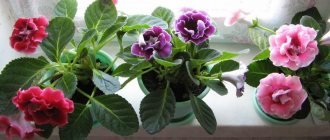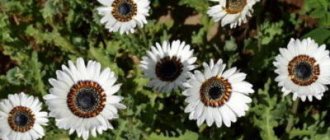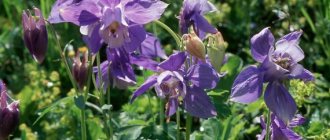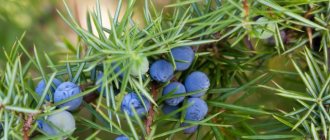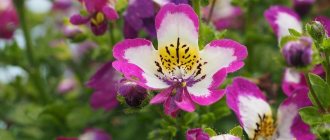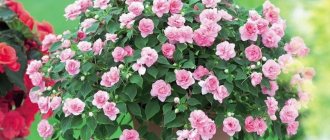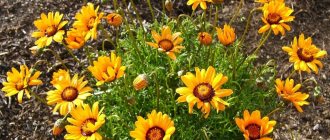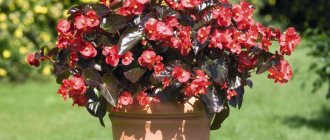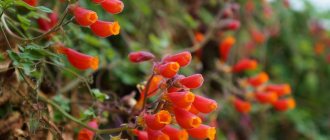Loading... Among herbaceous garden perennials, heuchera attracts attention due to its spectacular decorative appearance. Its colorful leaves, painted in almost all colors of the rainbow, look very beautiful in a flower bed and focus attention on small but beautiful bushes.
Heuchera leaves are shaped like geranium leaves, only they are denser and not monochromatic, but painted with different patterns and spots. This is probably why the flower is also called “spotted geranium”.
Heuchera reproduces both vegetatively and by seeds. The first method is used mainly for varietal specimens, since new plants retain all parental characteristics. However, seed propagation also gives good results: although the varietal characteristics are not all preserved, it is possible to obtain a new hybrid with an individual color.
Growing heuchera from seeds can be done either by sowing them in open ground in May, or in early spring for seedlings. The latter method is preferable, because at the end of spring, when the seeds are just sown in the flowerbed, the seedlings have already grown, become stronger and are ready to be transplanted into the soil.
Is it possible to grow heuchera from seeds?
Propagation of heuchera by seeds is quite often practiced by amateur gardeners, for whom the purebred nature of the plant plays a secondary role. At the same time, young seedlings differ from purchased seedlings in their high immunity, excellent health and ease of care.
Important! When growing heuchera with seeds collected independently, the seedlings lose their varietal characteristics, so it is worth purchasing planting material in the store.
On sale you can most often find the seeds of Heuchera villosa Michx. It has a fairly bright color and when grown from seed, the result can be seedlings with purple, dark purple, burgundy and bronze leaves.
Heuchera pilosa has large leaves with a velvety surface.
The seeds of the Emperor`s New Clothes variety are especially popular among flower growers. This is the name for a mixture of different flowers with corrugated and wavy leaves. Seedlings can have a color from light green or emerald to dark cherry.
The Emperor`s New Clothes variety bush looks very beautiful due to the “lace” edges of the leaves
Types and varieties of heuchera
Heuchera species are conventionally divided into mountain and forest. In mountain species, of which there are much more than forest species, the leaves are leathery, denser, and the rhizomes are adapted to survive in rocky soil, so rich soils are destructive for them. Forest species adapt more easily and quickly to fertile and moderately moist soils, and they are more spectacular and attractive than mountain species, which is why they are more often used in gardening. We will introduce you to the most commonly cultivated types of heuchera.
American heuchera (Heuchera americana) is a forest species that grows in eastern North America - on the rocky shores of the Great Lakes. What is attractive about Heuchera Americana is the leaves that form a rosette up to 20 cm high: rounded, heart-shaped, long-petioled, sometimes brownish-purple on the underside of the plate. The upper side of the leaves combines silver and velvet-brown spots and veins on a green background at different times of the year. A characteristic feature of cultivars of this species is a thin rim along the edge of the leaf blade. It can be crimson, coral or bright red. On peduncles up to 60 cm high, panicles of yellow-green flowers are formed. The species has been in culture since 1656. An interesting variety of this species, recently bred in New Zealand:
- Green Spice, or Eco Improvd , is a plant with green leaves covered with contrasting silver spots that do not lose freshness throughout the season. At a young age, a slight yellowness appears on the leaves of the plant along the green field, and purple-red areas around the veins, but over time, both redness and yellowness disappear, the silvery spots become brighter, and the green background is darker.
Heuchera micrantha is the most spectacular natural species of the genus. This is a perennial heuchera that is found in the wild on the North American Atlantic coast. It forms loose small-colored panicles of creamy-pink flowers with red-orange anthers on peduncles up to 60 cm high. The small-flowered leaves of heuchera, covered with gray-silver spots, resemble the foliage of Norway maple. There are natural varieties of the plant with purple leaves, and breeders have been able to enhance this trait and create forms with foliage in bright colors. The most famous varieties of Heuchera parviflora:
- Palace Purple is a plant up to 50 cm high. The leaves are bright purple with a metallic tint;
- Brassingham Bronze is a heuchera with bronze-brown foliage.
Heuchera cilindrica is a mountain species found in the highlands of the American Pacific coast. This plant is distinguished by large flowers of coral, pink, green or beige, located on peduncles up to 90 cm high, and small green, heart-shaped, rounded leaves with contrasting venation or a silver pattern collected in a compact rosette. The alpine variety of heuchera cylindrical has three cultivars:
- Greenfinch is a plant with greenish-cream flowers on tall peduncles;
- Hyperion is a compact form with red-pink flowers on peduncles up to 50 cm tall;
- Green Ivory is a heuchera with cream flowers on arrows up to 70 cm high and dark green leaves with bluish-red veining.
Blood-red heuchera (Heuchera sanguinea) naturally grows in the mountainous regions of the United States and northern Mexico, but, oddly enough, it is characterized by such high winter hardiness that it easily tolerates frosts in the middle zone. Americans call this plant red bell. The pubescent, round leaves of this species with a serrated edge are denser than those of other members of the genus. They form a rosette up to 25 cm high. On peduncles up to 50 cm high, small crimson, red or pink bell-shaped flowers are formed, forming a beautiful oblong panicle up to 20 cm long. The plant blooms in June-August from 60 to 90 days. The species has been in cultivation since 1882. The most interesting varieties of blood-red heuchera:
- Alba is a plant with green leaves and compact inflorescences ranging in color from white to dark red;
- Robusta is a variety with green leaves that turn red towards the end of the season and large dark red flowers;
- Snowstrom is an early flowering variety (May-June) with variegated white-green leaves and bright red flowers;
- Splendence is a variety with green leaves and compact inflorescences of bright carmine-red flowers;
- Splash-splash is a heuchera with green leaves with light green spots, the veins of which acquire a red-crimson color by the end of the season. The flowers are pink.
Hybrid heuchera (Heuchera x hybrida) - this category includes mainly interspecific hybrids obtained from crossing American heuchera, blood-red and small-flowered heuchera. Lemoine called this group of hybrids Heuchera x brisoides . These plants most closely resemble blood-red heuchera, but their terrestrial organs are larger. They bloom profusely for two months with pink, coral, white or red flowers. Their leaves are large, with contrasting veining, usually green with cream or white specks. The only drawback of plants of this group is that in a strong wind, the arrows overloaded with flowers can lie down. This species also includes more complex hybrids formed from Heuchera americana and Heuchera parviflora with the participation of other species of the genus. This group is called American hybrids ( Heuchera x americana) .
The best varieties of hybrid heuchera are:
- Amber Waves is a variety with corrugated and somewhat elongated leaves of amber-yellow color, especially bright in the spring under the sun's rays, but in the shade they acquire a light green hue. The flowers are light pink;
- Amethyst Mist is a plant with foliage of a dark amethyst color, unusual for heuchera, covered with silver spots. By autumn, the leaves become slightly crumpled and acquire greenish-burgundy tones, and the spots on them become lighter;
- Autumn Hayes is a variety with softly pubescent, light brown leaves with dark veins when young. Gradually the leaves become dark green with silver spots;
- Black Beauty - heuchera with highly corrugated, glossy leaves on the upper side of a dark burgundy-purple hue;
- Kan-Kan - a variety with highly corrugated red-brown leaves with light silver spots;
- Mint Frost is a plant with cream-colored branches and green leaves with silver spots that turn silver-bronze after frost;
- Cascade Don is a variety that changes the color of the foliage: young leaves are green with raspberry-purple areas and dark brown veins, but over time they become dark green with an admixture of purple hues and are covered with light silver spots.
Heuchera hybrids such as Coral Cloud, Brandon Pink, Firebird, Huntsman, Jubilee, Lady Romney, Hellen Dillon, Persian Carpet and many others are also popular.
Species such as heuchera pilosa and gooseberry leaf can also be found in
gardens, but they are of greater interest not for gardeners, but for breeders.
But a plant such as Heucherella - a man-made species obtained from crossing Heuchera with Tiarella cordifolia - is quickly gaining popularity in amateur gardening. The flowers of this plant resemble heuchera, but it inherited the shape of the leaves and small habit from tiarella. Today, three varieties of heucherella have already been bred:
- Bridget Bloom is a plant with green leaves and coral-red flowers on a peduncle up to 45 cm high;
- Rosalie is a variety with yellow-green foliage in spring, which darkens over time and becomes red-brown along the veins. On a peduncle 45 cm high, inflorescences of coral-pink flowers of a dark shade are formed;
- Quick Silver is a heucherella with brown leaves covered with a gray-ashy coating and inflorescences of silver-white flowers on peduncles up to 60 cm high.
Features of heuchera propagation by seeds
Growing is usually carried out by seedlings, since it is quite difficult to care for small seedlings in open ground. Therefore, sowing heuchera seeds for seedlings is done in prepared containers.
The seedlings themselves, grown in this way in a container, take root quite well after being transplanted to a new place.
When purchasing seeds, it is important to pay attention to the expiration date, since they remain viable for no more than 1.5 years, subject to vacuum storage. Self-collected material is suitable for sowing only for six months.
Leaf plate
Heuchera can be propagated with just one leaf. It's not that difficult if you do everything according to the rules. The fact is that simply taking part of a leaf is not enough; you need to keep a piece of the stem on it. The stem contains growth buds, which eventually form new leaves.
Leaf cuttings can be taken at any time during the growing season, but if taken in late fall, they may not have time to root before winter. But if it is possible to move young seedlings indoors for the winter, then cuttings can be taken in the fall. You can combine two methods - dividing the bush and cuttings, then you can use the material left over from the division.
Prepare the planting mixture in advance. A mixture of sand, vermiculite and peat in various proportions has proven itself well. The best option can be selected experimentally, but usually all components are taken in equal parts. Recently, a new material has been used as a planting medium - coconut fiber. It is good because it is absolutely sterile, that is, it does not contain any pathogens that could harm young plants.
Prepare cutting tools. The knife must not only be sharp, but also clean, otherwise diseases can be transmitted from one plant to another. To avoid this, dip your knife in a diluted bleach solution after each cut.
Cut the heel cuttings with a clean, sharp knife. If the cutting contains one leaf, then the size of the “heel” should be approximately half a centimeter. Larger cuttings with multiple leaves can be used. However, if there is a large surface area of the leaves, the cutting may become too dry, as the leaves will evaporate water. Therefore, to reduce moisture loss, large leaves must be reduced by cutting them in half. Small leaves can be left untouched - they will produce nutrients for the plant.
Keep the cutting in a solution of any growth stimulant or sprinkle the cut with Kornevin. This will help the plant endure stress and take root faster.
Plant the cuttings in a moist planting medium and shade them from direct sunlight. In open ground, cuttings are often covered with a jar or planted under arches. It is better to plant the leaf cuttings in an inclined position and so that the “heel” is at a depth of about 2-3 centimeters from the soil level. This is due to the fact that it will be difficult for newly formed leaves to overcome a thicker layer of soil. If everything is done correctly, the first roots will form in 4-6 weeks.
If you root leaves in the fall, it is better to plant them in seedling pots, which can be moved to a bright, cool room in winter. In this case, fill the pots with planting mixture and moisten well, then add a little more mixture because it will settle after wetting. After this, use a pencil to make a depression in the mixture and insert the end of the cutting into it
Gently press the mixture around the cutting. Cover the pot with a plastic bag and tie the bag securely with a rubber band
If necessary, place one or two sticks or plastic straws in the pot to keep the plastic from touching the surface of the leaf. This prevents condensation from getting from the bag onto the sheet.
To learn how to propagate heuchera, see the following video.
Soil preparation
Proper soil preparation also plays an important role. Often gardeners mix it themselves. For this, there are special proportions, the ratio of which is important to observe.
To obtain a high-quality substrate, mix 2 parts of turf soil with ½ part of coarse river sand and 1 part of peat. In addition, 200 g of wood ash or 2-3 tbsp are added to the resulting mixture. l. dolomite flour (per 1 kg).
Attention! A special store-bought mixture is also suitable for sowing seeds, which must be combined with coarse sand in a ratio of 10:1.
Some gardeners use vermicompost with coconut fiber (1:2) as a soil mixture.
Before use, the soil must be disinfected; to do this, you can pour boiling water over it or heat it in the oven. It is especially important to disinfect soil prepared at home.
For disinfection, you can use a solution of manganese or fungicide
Fully prepared and disinfected soil is placed in a container after a drainage layer of expanded clay or other material with similar properties.
Important! There should be at least 1.5 cm from the surface of the substrate to the edge of the container.
Heuchera pests and diseases
Heuchera diseases and their treatment
Heuchera has virtually no health problems. A few problems that you may encounter are root rot, rust, spotting and powdery mildew, and if one of these diseases affects your heuchera, the blame for what happened lies entirely with you, since fungal diseases are usually the result of improper watering.
Root rot develops as a result of regular stagnation of water in the roots. The cause of rotting of the root system is usually excessive or too frequent watering of soil with poor moisture permeability. External manifestations of the disease: lethargy of ground organs, drying out of leaves and the formation of constrictions and brown spots on them, and then lodging of the plant. Instances in which rot has already affected the root system cannot be saved: they must be removed. But while still healthy plants should be immediately treated with a solution of a fungicidal drug, the main thing that needs to be done is to review the watering regime or replant the heuchera in well-drained soil. You can improve the permeability of the soil by digging it with coarse sand or fine gravel.
Signs of rust are red oval pads on the underside of the leaves. As the disease progresses, the pads grow and merge with each other. Light yellow spots appear on the upper side of the leaf blade. Affected leaves turn yellow prematurely and fall off. If symptoms of rust are detected, you need to remove diseased leaves and treat the bushes and the soil under them with one percent Bordeaux mixture or solutions of fungicidal preparations: Abiga-Pika, Cumulus, Strobi or Polyram. One treatment may not be enough, so prepare yourself for a long battle.
Powdery mildew is a real scourge of gardens and vegetable gardens. This disease can be recognized by a sloppy whitish coating that covers the leaves and stems of plants and gradually darkens, as well as by dark brown balls on young stems and the surface of leaves. As a result of the development of the disease, the plant loses its attractiveness, its affected organs darken and die, the inflorescences do not form ovaries, the buds lose winter hardiness and die. The drugs Topsin, Thiovit Jet, Fundazol, Quadris, Topaz and other fungicides will help you quickly cope with the infection.
Spots are the most common types of diseases in nature, affecting leaves, stipules, petals, ovaries, fruits, seeds and shoots of plants. Spots come in different shapes, sizes, colors and shades. They can be flat or convex, perforated, with or without a border. The greatest danger of spotting is for young plants. In severely affected specimens, physiological processes are disrupted, which leads to slower growth and development, weakened resistance to other diseases, not to mention the loss of decorativeness. At the first signs of disease, treat the heuchera leaves with a solution of Vitaplan, Gamair, Baktofit or Fitosporin-M, prepared in accordance with the instructions.
Heuchera pests and their control
Heuchera is resistant to pests from the insect world, but slugs and snails often damage young shoots and leaves of the plant. If there are only a few shellfish, scatter the kitchen spices that every housewife has around the area: allspice, cilantro, dry parsley, rosemary - their aroma should repel pests. Beer baits give a good effect: a jar, one-third filled with beer, is buried in the evening on the site so that its neck does not protrude above the surface of the ground. The slugs will definitely crawl towards the beer and fall into the trap.
If there are too many slugs, then the drugs Thunderstorm, Ferramol, Meta and Slug Eater will help you destroy them.
How to properly plant heuchera seedlings
There is no specific scheme for sowing heuchera seeds for seedlings. It is enough to distribute the planting material evenly over the entire surface of the soil. Use a sheet of paper folded in half. If there are few seeds, it is recommended to mix them with sand, this will help achieve uniform distribution.
The planting material does not need to be deepened; it is enough just to sprinkle a thin layer of sand on top. Then the spray bottle is used to moisten the container and cover it with film or glass to create a greenhouse effect.
Answers to readers' questions
Plant lifespan
After three to five years, the plant loses its qualities, the bush disintegrates and the heuchera needs to be dug up. The old bush is divided into several parts and planted. Young plants are obtained from them. So heuchera has a long, renewable life cycle.
Why does heuchera grow poorly?
The reason may be too fertile soil or excess fertilizer due to which by autumn a large bush grows and too many buds are laid. Over the winter, the root system weakens and cannot “feed” so many new shoots.
Perhaps some conditions do not meet the requirements (humidity, windy place in the garden, too dark or, conversely, too bright place in the garden).
Flower care in winter
In winter, the flower does not require care, but in the fall you need to take care of it. Pruning is strictly prohibited; the bush is carefully covered with foliage or spruce branches. It is imperative to mulch the soil with compost or rotted tree bark. You can add wood ash. In the spring, the mulch is removed.
Why does heuchera not sprout from seeds and what to do
The main reason that heuchera seeds did not germinate is that they are spoiled, because germination remains after collection for no more than six months. In this case, you need to purchase new planting material from a specialized store, be sure to check the expiration date, and re-sow.
The second reason may be improper treatment of the soil or container, as well as non-compliance with sowing rules. Since heuchera seeds are very small, they cannot be deepened or compacted.
Another reason could be improper watering. It should be done with a spray bottle, otherwise everything will simply be washed away with water. The soil must be moist. It is important to ensure that moisture does not stagnate.
Choosing a place for heuchera in the garden
Heuchera will feel best in shaded areas of the garden: but the shade should not be absolute, but sparse. The crown of spreading deciduous trees is well suited for creating such shade. Heuchera can be used to decorate the western and eastern parts of your site. This way the heuchera will receive the right amount of light. Heuchera, planted on the sunny side of the yard, requires abundant watering. For a sunny side, you should choose a heuchera with a brighter color. It will look very bright under the rays of sunlight. Red-colored varieties need sun more than others, since it is sunlight that maintains the red tint. In the shade, expected to be red, heuchera will grow green. The soil before planting heuchera does not require any special preparation, with the exception of checking for acidity reaction using special indicators that can be purchased at flower shops. Heuchera prefers soil with neutral or weak acidity. Heuchera cannot grow on calcareous soils; fertilizers of this kind are also not suitable for it. By increasing the alkaline content of the soil, limestone can destroy the plant. Heuchera can grow even in rocky soil and does not require troublesome care. Rocky soil is a familiar environment for this plant. Nevertheless, in soft, nutritious, fertilized soil, the flower will grow much more magnificent and beautiful. Heuchera should not be planted in lowlands. The accumulation of groundwater and sedimentary water in the soil can lead to the death of its roots. It is important that the soil is well drained. This condition will ensure rapid absorption of moisture into the ground and protection of the delicate roots of the plant from rotting.
Microclimate
After sowing seedlings, it is necessary to wipe the glass or film daily to avoid the formation of condensation, otherwise the seeds will become moldy. In order not to waste time on this, you can simply turn the shelter over to the other side.
As soon as the first shoots appear, you should make holes in the film; if glass is used, then open it slightly. This procedure is necessary to ventilate the seedlings. After 10 days, the shelter can be removed completely.
As soon as 3-4 full leaves have appeared, the seedlings are picked, followed by replanting at a distance of at least 3-6 cm from each other.
Features of cultivation
There are no obvious features or difficulties in growing heuchera, but this plant has characteristic features that will not hurt you to know. So:
- for decorative deciduous varieties of heuchera, if you do not have the goal of collecting seeds in the fall, it is better to remove the peduncle as soon as it appears: they grow much higher than the bush and have an unkempt appearance, which damages the decorative qualities of the plant;
- peduncles of decorative flowering varieties are removed immediately after the heuchera fades;
- Over time, the lower leaves on the bush fall off, and the heuchera looks untidy. You need to dig up the plant before flowering and transplant it together with the earthen ball into a deeper hole to hide the bald stem;
- at the beginning of growth, young heuchera leaves are bright and translucent, like flower petals, but as they mature, they thicken and darken;
- Heuchera goes well with primroses, daylilies, astilbe, bergenia and ornamental cereals.
In the photo: Variegated leaves of heuchera
Watering and fertilizing schedule
It is necessary to water heuchera seedlings very carefully, trying to slightly waterlog the soil, otherwise this will lead to the development of fungal diseases. If you don’t have a spray bottle, you can use a syringe or syringe.
The interval between waterings should be at least two days. In this case, after each, it is necessary to loosen the soil and ventilate the container.
Feeding seedlings is also important; it is necessary for faster development and strengthening the immunity of seedlings. They begin to perform it only after the seedling has already formed at least two true leaves. Special mineral complexes are used as fertilizers in the form of a solution with a low concentration.
Sowing seeds
Fill the tubs with soil mixture and lightly compact them. We sow the seeds evenly over the surface of the ground and spray them with a spray bottle without covering them with soil. Such an event is enough for a drop of water to carry a small seed with it to the depth that will be optimal for germination.
Seedling care
The germination period is the most critical for heuchera.
The bowl is covered with glass or film, but in such a way that it is possible to turn the coating over daily to remove condensation. If it is impossible to remove large drops, they will become a source of proliferation of pathogenic microorganisms and the crops will die.
You need to wait 17-20 days for the emergence of seedlings. However, all this time it is necessary to spray the crops with warm water and turn the glass at least twice a day.
Lighting requirements
Bowls with crops are placed on a bright windowsill or under a phyto lamp. This will allow the seedlings not to stretch out.
Seed germination in an insufficiently lit place will lead to rapid lodging and loss.
Watering heuchera
It may be interesting Growing Lavatera at home Let's sow cornflower and grow chamomile Super-remedy "Troichatka" for germinating roses As such, seedlings are not watered.
The delicate root system needs constantly moist soil, but excess moisture can destroy the seedlings. All watering is carried out by spraying. At this moment, the seedlings do not yet need an abundance of water; the root system is very shallow.
When choosing a sprayer, you need to ensure that the water droplets are very small, ideally creating a fog-like state.
When the seedlings grow up, you can begin full watering. When watering the plant, the amount of water should be sufficient so that the excess flows into the pan and is immediately removed.
Watering is carried out with water at room temperature, preference is given to rainwater. Watering with acidified water will also have a good effect on the plant. Add 2-3 drops of nitric acid or, in extreme cases, citric acid per liter.
Dive
When planting grown plants, they try to capture the root system with a lump of earth. An adult Heuchera has rhizomes, and they begin to form at a young age, so it is important not to disturb their growing season. The optimal age for the picking period is the presence of 3-4 true leaves. The plant has this condition at the age of 2 months after germination.
Transplantation is carried out in specially equipped mini-greenhouses, which can be closed from the scorching sun and heavy rainfall. The greenhouse system allows you to create an optimal microclimate that will ensure 100% survival rate and replanting will not affect the growth rate of heuchera.
When creating a microclimate, it should be taken into account that the plant does not tolerate not only scorching sun, but also high temperatures. The optimum for heuchera is 18-19 ᵒC. Higher temperatures cause the cuttings to stretch, the leaves become pale, dull, and the bushes themselves lose their compactness.
If planting is carried out in individual containers, then it is best to choose peat tablets. You can take them factory-made or prepare them yourself from the same soil mixture that was used for sowing the seeds.
Top dressing
Heuchera does not have increased requirements for soil fertility and when sowing and planting into purchased, universal soil mixtures, no fertilizing is required.
If the soil mixture is prepared independently, then after diving, after 3-4 weeks, you can fertilize with universal fertilizers for decorative deciduous plants.
When choosing a dose, you should read the instructions and reduce the concentration by half. When feeding heuchera, the rules are that it is better to underfeed than to overfeed the plant.
Description of Heuchera
Heuchera plant purple midnight rose midnight rose in a flower bed photo
Heuchera is a real find, because its palette will impress even the most demanding gardener, both professional and amateur. It seems that this culture collected all the colors for itself. Starting from silver, yellow, green and ending with black. These are also all shades of red, including purple, burgundy and soft pink. Every year, breeders delight gardeners and designers with new heuchera hybrids. All kinds of patterns, veins, and spots are also characteristic of heuchera. The leaves are leathery, toothed.
There are 3 types of texture:
- smooth
- corrugated
- curly.
Heuchera flowers will delight you until frost with shades of pink, white, red and cream. Small bells are collected in a small panicle, attached to thin tall stems. The seeds are in a small so-called capsule, about the size of a poppy seed.
Heuchera varieties are divided into two categories:
- Ornamental foliage is a plant with gorgeous leaves, such as American Heuchera.
- decorative flowering, for example, blood-red heuchera, which is valued in landscape design for its flowers.
Heuchera is a chic decoration for artificial ponds, a beautiful container plant, some varieties are used for cutting. Looks great with hostas and astilbes in mixborders.
Variety selection
Currently, over 400 varieties of heuchera are known. Moreover, this figure is constantly growing. Every year 10-30 new specimens appear. Breeders, by crossing, develop increasingly brighter varieties of this plant. However, gardeners have favorite varieties that they prefer over all others.
- One of these is the Gypsy Violin variety , which is known for its frost resistance. The height can be 40 centimeters. The flowers are red and white in color and resemble bells in arrangement and shape.
- “Carmine-red” heuchera is bright and memorable. Its red leaves with jagged edges are very noticeable. They become especially colorful after the first frost. The flowers of this variety are small and red. It is worth emphasizing that flowering occurs in the summer months.
- A variety called “Comet” remains in the memory for a long time. The rich green leaves and bright red flowers look very expressive. This heuchera is loved for its special unpretentiousness. A decorative border made from this variety looks great.
- Heuchera "Fading Fire" attracts attention with its unusual leaves. The color is dark red with a purple or black tint and really resembles a burning fire. The plant looks especially good in alpine hills.
- The variety “Purple Castle” has a spectacular appearance , which is also frost-resistant and easy to care for. This plant belongs to the type of small-flowered heuchera and is distinguished by purple leaves with a burgundy tint. The shape of the maple leaf makes it especially charming.
A few words about the plant
Heuchera is a unique perennial plant belonging to the Saxifraga family, growing well in flower beds, gardens, and parks.
The plant requires relatively little care and has no special soil requirements. These are evergreen garden perennials, one of the few species that retain their decorative appearance all year round, even in winter. In winter, heucheras usually do not lose their aerial parts; in spring they produce new leaves from the root system.
The fashion for growing heuchera appeared in the 90s of the 20th century - initially they were used mainly to decorate balconies and terraces, as an addition to flowering plants. The homeland of the perennial is North America. In the wild, heucheras grow on slopes and rocks in Canada and Mexico.
The most decorative part of the plant is the leaves on long petioles, heart-shaped or round in shape. Individual varieties differ significantly. In addition to standard shades of green, leaves come in yellow, red, purple, and blue colors; varieties with interesting patterns on the surface are popular. The plant is not too tall - the maximum height is 40-45 cm. Heuchera creates a fairly dense bush, which enhances its decorative character.
The flower received its name in honor of the famous German botanist Johann von Heicher.
The heuchera flower blooms occasionally, but not particularly attractively. Paniculate inflorescences appear from June to April (single ones - from May).
The inflorescences with bell-shaped small flowers, green, white or pink, are not particularly attractive.
Only Heuchera × brizoides is distinguished by decorative flowers.
Photo. Heuchera shaker - flowers
The main advantage of heuchera is that it is decorative all year round, regardless of flowering.
To show all the beauty, the plant should be planted in a large group. You can freely mix species and varieties - in such a multi-colored combination the flower looks most beautiful, especially the varieties of small-flowered (Heuchera micrantha) and blood-red crane heuchera (heuchera sanguinea). Shrubs and other landscape plants that bloom in spring provide a good background for varieties with decorative leaves.
Wintering Heuchera
This crop overwinters easily ; a little preparation is enough for comfort. Heuchera's winter hardiness is excellent, but in harsh winters you should play it safe. Leave the dried leaves untouched; later in the spring, after frosts, they are removed with pruning shears to activate and start the growth of new buds. This will additionally protect the plant from severe frosts. The main shelter should be constructed from oak leaves, spruce branches, hay, pine needles, straw or other similar material.
We propagate heuchera by dividing the bush
After 3-4 years, the bush must be divided into several parts. This is caused by the fact that in an adult plant the rosette grows upward, the lower leaves dry out, exposing part of the stem at the roots. Heuchera takes on an unpresentable appearance, begins to hurt and does not tolerate temperature fluctuations.
To propagate heuchera by division, an adult bush is completely dug up, being careful not to damage the root system. The soil is washed off the roots, if necessary, they are trimmed a little and dried or rotten parts are removed. The plant itself is divided into several rosettes and planted in prepared soil. It is advisable to add a layer of compost and a drainage layer of coarse sand or stone chips into each hole.
You need to choose a place for new young bushes so that they are exposed to diffuse sunlight most of the day. If it is difficult to provide partial shade, the seedlings can be covered with wooden slatted boxes, which will protect the young shoots from the scorching rays of the sun and ensure good ventilation of the soil. Rooting occurs after 1.5-2 months.
Features of transplanting a flower to a permanent place
As a rule, the plant is planted in open ground in late spring, but planting in the fall is also possible if the weather is warm enough.
Important! When planting in autumn, the soil must be mulched with bark or wood ash for the winter. After the end of spring frosts, the mulch must be removed.
You need to choose a place for planting based on the characteristics of the variety of a particular plant. But as a general rule, they cannot be planted in places where a lot of water accumulates - the plant does not like excess moisture. Most varieties should be planted in well-lit areas, but without direct sunlight at midday. Otherwise, the decorative effect of the leaf will suffer: it will change shape and lose color. The ideal place is where there is a lot of sunlight in the evening or morning and shade during the day.
However, this does not apply to varieties that have burgundy or red leaves. When there is insufficient light, they lose this color and become an unsightly green.
Important! In general, heuchera is resistant to pests and diseases, but if the humidity is too high, it can be damaged by powdery mildew. The thin roots of the plant can be undermined by weevils, and the leaves are loved by slugs.
When planting a plant in a permanent place, maintain a distance of 20-25 cm between seedlings.
The soil should be loose and well drained. By winter, such plants will form a dense rosette. In general, they are able to survive the winter without shelter, but in the first year of life it is better to cover them with spruce branches.
Growing heuchera from seeds is not difficult. True, in this case one must be prepared for the loss of some species characteristics. But the procedure for sowing and growing seedlings is no different from the usual growing of plants from seeds.
Care instructions
What measures need to be taken for the successful growth and development of heuchera grown from seeds. If the plant's flower stalks are very elongated, they can be tied to pegs and cut off immediately after flowering.
As for watering, it is better to do it after the sun has set: this measure will prevent burning of the tender leaves. Rainwater is best suited for irrigation. But it can be successfully replaced by water enriched with citric or nitric acid: the acid concentration should be very weak. This measure will help maintain the required level of soil acidity.
You should know that heuchera leaves are not removed for the winter, even if they are dry. The fact is that the leafy layer on top will protect the roots of the plant from freezing. It will be possible to remove old foliage in the spring, when young foliage begins to emerge to replace it.
Before the winter cold, do not forget to cover the bushes with fallen leaves (preferably oak). It is especially important to follow this rule for those plants that will have to survive their first winter outside.
Heuchera grown from seeds retains its decorative qualities for 3-5 years. After this, the bush begins to go bald in the middle, which worsens the appearance of both the plant itself and the flower arrangement in which it is included. In addition, the roots, located shallowly underground, by this time completely come out, giving the plant a sloppy, unkempt appearance. For lovers of house plants, it is worth learning more about juniper roots.
To eliminate this aesthetic defect, the old plant is dug up and divided into several parts: each part with roots can be used for further vegetative propagation of the flower. The plant successfully survives this manipulation, and immediately after rooting, parts of the heuchera quickly begin to grow.
